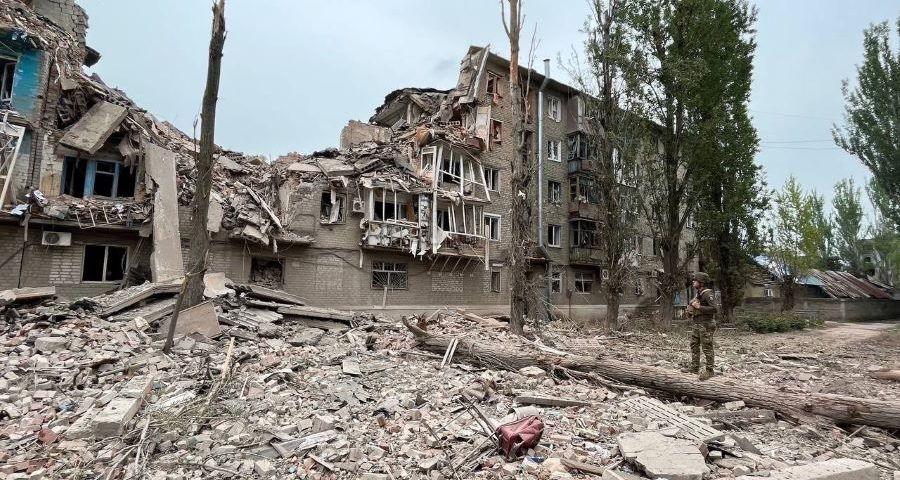Doing business

In the past month, rashist troops shelled the Sumy region more than 400 times. This region suffers daily from enemy attacks due to its proximity to the russian federation. The aggressor troops predominantly used artillery, MLRS, mortars, and aerial bombs. Dozens of houses, both private and multi-story buildings, were destroyed to the ground, and about a hundred civilians were wounded.

In May, russian troops inflicted even more damage and destruction on Kharkiv Region than they did on Sumy Region. During the month, almost 500 shellings, in addition to the above-mentioned types of weapons, cruise missiles were also used. Both residential, industrial and critical infrastructure was hit. Several dozen people were injured.

The situation in Kherson Region is similar, with about 500 shellings, mostly by mortars, artillery, and MLRS. The russians also used UAVs and cruise missiles to strike residential infrastructure, warehouses, and industrial facilities.

May was one of the toughest months for Kyiv and the capital in particular since the beginning of the year. In the last two weeks alone, the city has suffered more than 10 drone attacks, several hundred objects, mostly residential buildings, have been damaged, and there have been several deaths and dozens of injuries. In addition, the capital was repeatedly shelled by Iskander ballistic missiles.

The Chernihiv region, which directly borders on the russian border, also suffered from shelling. Mortars, multiple rocket launchers, and aerial bombs destroyed several dozen residential buildings, damaged power lines (several thousand civilians were left without electricity), and destroyed several dozen hectares of coniferous forests.

Zaporizhzhia region, half of which is now temporarily occupied, has been and continues to be shelled heavily by the enemy on a daily basis. In the past month, the number of attacks almost reached the 500 mark. S-300 systems, UAVs, artillery and cruise missiles are predominantly used for this purpose. Industrial enterprises and residential buildings are the first to be hit, while critical infrastructure and agribusinesses are also affected.

Dnipropetrovsk region, which is a security hub of the whole Ukraine and the place with which four front regions border on each other, is regularly attacked by the enemy with various types of weapons. Due to its remoteness from the actual location of russian federation troops, the aggressor cannot reach most of the settlements with artillery, mortars and MLRS (except Nikopol district, because it is shelled daily from Enerhodar), so the main means of destruction are cruise missiles of the X type, UAVs and ballistic missiles. The latter three types of weapons in May alone destroyed a medical facility where both civilians and wounded military personnel were treated, several dozen houses, industrial and storage facilities, as well as critical infrastructure in the Nikopol district in the center of the region, the city of Dnipro. As a result, several dozen people were killed during this period, including children and the elderly, and many more were wounded.

One of the fiercest sections of the front and the most devastated region was Donetsk region, because here our Defense Forces were repelling enemy attacks, which were hitting Avdiivka, Mariinka, Bakhmut, Kostyantynivka, Chasiv Yar and other populated areas brutally every day. It is difficult to calculate an exact figure, but the number of shelling reaches several hundred. Most of the shelling was carried out by ground attack aviation, which dropped bombs on the towns, while artillery, incendiary shells, mortars and MLRS were also shelled. Hundreds of houses were destroyed, and most of the towns mentioned above were completely uninhabitable, in fact completely destroyed.

There is a similar situation in the temporarily occupied Luhansk region, where the enemy strikes populated areas close to the positions of the Defense Forces on a daily basis. Almost all types of weapons are being fired on. There are now more than 40,000 complaints from citizens regarding destroyed property.

The other regions were subjected to fewer attacks, but the scale of the destruction was also impressive. In the Odessa region, there were several hits from X-type cruise missiles on warehouses and industrial facilities. As a result, more than 10,000 square meters were destroyed. Enemy UAVs flying by were shot down, and their downfall caused roofs and residential buildings to catch fire.

Among the southern regions, Mykolaiv region was also shelled several times during the month. As in Odessa, here the enemy used cruise missiles and kamikaze drones, causing damage to an industrial enterprise and several residential buildings.

The central regions (Cherkasy, Kirovohrad, and Poltava) suffered the least damage. Here, there were mostly sporadic, point-by-point strikes by cruise missiles and UAVs against industrial buildings. The situation is similar in the west of the country – Lviv, Zakarpattia, Ivano-Frankivsk, Volyn, Rivne, Ternopil, Chernivtsi, Khmelnitsky, Vinnytsia, and Zhytomyr regions were hit with the same types of weapons. Infrastructure and industrial facilities were mostly damaged and destroyed.

Photo materials were taken from the official information resources of the State Emergency Service, Dnipropetrovsk, Kharkiv, Kherson, Donetsk, Mykolaiv, Odessa, Luhansk Regional military administrations, the State Border Guard Service, as well as the National Police of Ukraine.